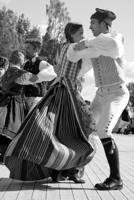
|
The Society of Folk Dance Historians (SFDH)
On the Dancing and Teaching
[
Home |
About |
Encyclopedia | CLICK AN IMAGE TO ENLARGE |

|

 The Hambo belongs to the family of Swedish dances known as Polska, a musical rhythmic form dating back over 350 years. Its full name rightly being Hambopolska, it is the most popular survival of a dance type which was for two and a half centuries the "national dance" of Sweden. Other Polskas still done today include: Fyramannadans (sleng-polska), Snurrbocken (Delsbo-polska), various dances from the Swedish province of Dalarna (Dal-polskas), and related Norwegian folk dances such as Springar and Springpols.
The Hambo belongs to the family of Swedish dances known as Polska, a musical rhythmic form dating back over 350 years. Its full name rightly being Hambopolska, it is the most popular survival of a dance type which was for two and a half centuries the "national dance" of Sweden. Other Polskas still done today include: Fyramannadans (sleng-polska), Snurrbocken (Delsbo-polska), various dances from the Swedish province of Dalarna (Dal-polskas), and related Norwegian folk dances such as Springar and Springpols.
As with nearly all Polskas, the important part of the Hambo is the partner turn. The open pattern steps which precede the turn have changed, and continue to change, with time; they also vary according to location. It is the polska turn which makes the Hambo typically Swedish, and it alone has remained essentially the same. Therefore, it behooves the Hambo instructor and novice alike to spend the greatest share of his time in working on the turning step. Once properly mastered, it can be used for any number of versions of the Hambo.
The following "tips" on the dancing of the Swedish Hambo are given with the hope that they may be of some enlightenment and assistance to both the teacher and the lay dancer. In gaining a full measure of what the Swedes aptly call "dansglädje" (joy of dancing), whenever the opportunity to do a Hambo arises. It may then deservedly become, more than ever, "the favorite dance of all."
MUSIC
It should go without saying that proper music is of the utmost importance to the satisfactory execution of any dance. Because the Hambo is a type of Swedish Polska, it is essential that the music used for it be that intended for such a dance. It is NOT "all right" to substitute waltz or other 3/4-time music, simply because it is triple-measure. The Polska has a rhythmic character of its own, not unlike that of many of the classical works of Bach and Händel. Instead of a simple "ONE, two, three" with the stress always on the first beat of the measure, Polska rhythm has a secondary emphasis in the third beat of each measure which serves to "lift" the music onto the following first, or primary, beat. thus, one "taps out" polska music as: (three), ONE, —, three, ONE, —, three, etc. This distinction is vital to the proper interpretation of polska rhythm, and absolutely essential in giving the Polska its distinctive "lilt."
As to tempo, unfortunately in the United States, the Hambo is, more often than not, played too fast to allow for proper execution of the polska step. Hambo music should be moderate in tempo, deliberate but relaxed. For, unless it be the Stockholm Hambo (which has an altogether rhythmic styling), the Hambo's metronome count is quite temperate.
There are literally hundreds of authentic Hambo tunes, many of them traditional folk melodies. It is something of a "cultural crime" for orchestras to play them as they definitely were not intended to be played. But even more unforgivable is to indiscriminately pass off Waltz or other 3/4 music as "Hambo" music. It is true that the Mazurka comes closer to the Hambo, and polska rhythm in general, than does the Waltz. But why substitute when the "real thing" can be had without any great difficulty?
DANCE POSITIONS
The Waltz hold or "social dance position" is never used in the Hambo. It simply does not lend itself to the Hambopolska turn, particularly with a "dip." Furthermore, it is historically not a traditional folk dance hold in Sweden, as it is in neighboring Norway and Denmark.
For the Swedish Hambo, either regular shoulder-waist position, or Swedish closed "folk dance hold" is used. (Man's right arm around the woman's waist, the man's left arm sharply bent with his hand open upward; the woman's left hand on the man's right shoulder, woman's right arm held straight out from the shoulder with her elbow in man's left hand and her right hand holding man's left arm just above his elbow.)
STEPS
One great distinction between the Polska turning step (as found in the Hambo, Snurrbocken, Springpols, and other Polska-type dances) and the turning step of most other round dances (for example, the Waltz, Polka, step-hop, and two-step), is that whereas in the latter it takes two measures of such step to make one complete turn around with a partner, the Polska requires only one measure per single revolution. This is what gives a Polska dance such seemingly great velocity and consequent exhilaration in the turn, while at the same time the music remains comparatively unhurried and "easy going." Starting each turning step with the same foot makes possible this phenomenon.
Contrary to some apparent beliefs, there are, properly, NO hops, skips, or jumps in the hambo turn! The steps should be smooth and relaxed, never "jerky." They should flow with the music but at the same time be fully under control. In the case of the man particularly, the feet are held close to the floor, "well grounded" all of the time. Also, the steps should be short and close together, the man stepping forward in line of direction only on the first beat of each measure, that is, as he steps on his right foot (this is his "leading" step).
Lastly, it is essential that the Hambopolska turn be conceived as as three-count step, with one step movement on each beat of the measure. Because each measure must begin with the same foot, while the music is "uneven" time (that is, 3/4), this obviously means that one of those three movements must involve no transfer of weight onto the opposite foot. Thus, the man's step is: Right, Left, Both (with primary weight remaining on the Left). The concept of "Both," rather than simply "touch," tends to keep the feet and weight closer to the floor throughout all three beats, which is highly desirable. There is often a tendency for the man to "skim over" this non-weight-shifting step, leaving the right foot raised from the floor (on the 3rd beat) instead. This is to be discouraged, for it invariably leads to one of two things:
- the turn becomes somewhat unstable, losing its "grounding" during a third of each measure, or
- it becomes uneven, the first step (right) being held down for two counts instead of only one, rendering the turn no more than a syncopated pivot.
The woman's turning step is also a three-count movement: Left, touch Right (no shift of weight), Right.
STYLING
The Swedish Hambo is properly a graceful dance – not the strenuous acrobatic ordeal that some people make of it (and even seem to think it must be!). It should be danced smoothly and easily. (Remember: over in Sweden, in Dalarna, often every other dance is a Hambo!)
Relaxation is the cue. The dancer must not be tense, but "loosen up" so as to be able to more or less unconsciously respond to the subtly syncopated Polska "lilt." He should "float with the music," so to speak.
Actually, the Hambo is difficult only in the sense that it perhaps takes more than the accustomed amount of coordination and control But it's worth the practice. Once mastered, it has no equal. So take it easy! You'll last longer, and gain much more enjoyment from this dance which, in one form or another, has itself lasted a dozen generations!
DOCUMENTS
- Gordon Tracie, an article.
- Sweden, a country.
Reprinted from the 1954 College of the Pacific (Stockton) Folk Dance Camp syllabus.
This page © 2018 by Ron Houston.
Please do not copy any part of this page without including this copyright notice.
Please do not copy small portions out of context.
Please do not copy large portions without permission from Ron Houston.